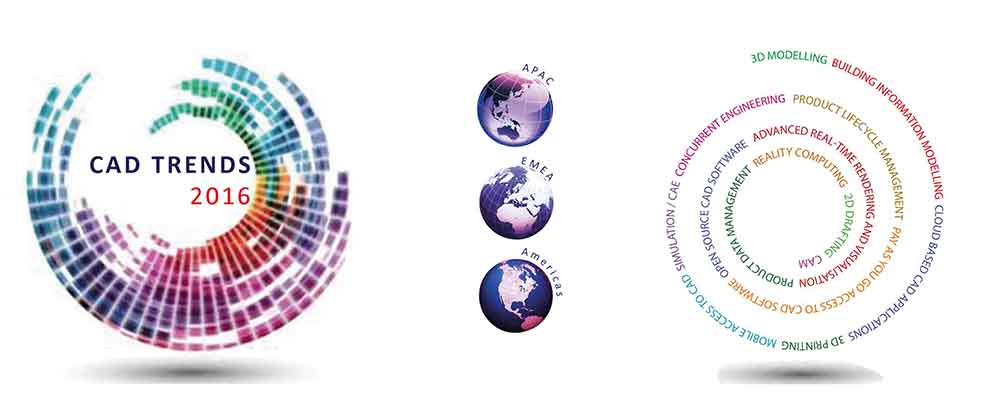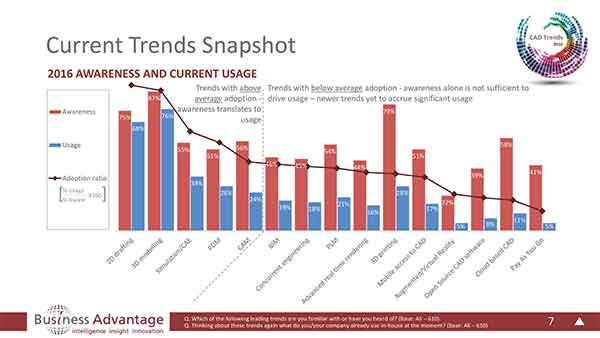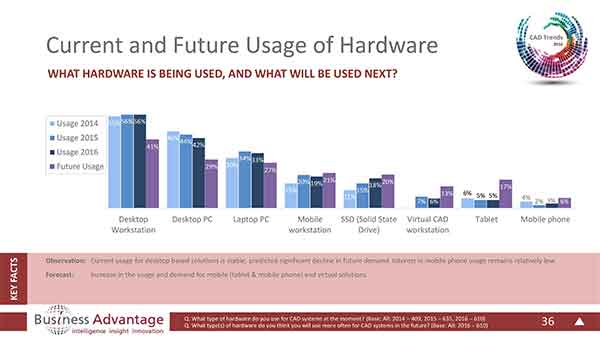
Which direction is your technology heading? PW takes a look at the Business Advantages 2016 survey to give you a peek into the future.
Is your team considering changes in technology, tools, and workflow? Are you evaluating new technologies to uncover their business value?
Looking for trends in technology combines awareness, current usage, and expected future usage of technology. For you, workstation users, technologies ranging from 3D modeling to remote workstations to cloud-based CAD to high-end rendering to augmented reality are technology topics of interest in your business.
PW reviewed a top-level report from a group called Business Advantage (BA) which examines technology important in design, engineering, architecture, and manufacturing. The BA report looks at over a dozen topics. The report is filled with good information and PW recommends that you download the top-level report for more detail.
Cloud-based CAD, Pay-as-you-go, advanced rendering, CAE, and augmented reality caught our eye. Hardware is also a focus at PW and the report touches on hardware technology trends for desktop workstations, mobile workstations, basic PCs, SSDs, as well as remote workstations.
Cloud-based CAD
58% of respondents voiced awareness of Cloud-based CAD. Perhaps that number is surprising only for the fact that it is not somewhat higher. Cloud-based CAD has been a reality for several years and the launch of Onshape represents the first pure, cloud platform CAD company on the market. The company is well-funded and has a solid CAD technology background. Even if PW ignores the competition, the news around Onshape seems like enough to push awareness of Cloud-based CAD above the 60% mark.
The surprising number, however, is the 11% adoption of Cloud-based CAD. This is higher than we would have expected. At PW, we could easily imagine a 70% or 80% awareness level side-by-side with a 5% adoption level. As for adoption of Cloud-based CAD, we imagine that this refers to in-house evaluation or use on some initial, small projects.
We would be extremely surprised if this represented an 11% of all CAD usage. This is a particularly suspicious number given that Cloud-based CAD is essentially 100% subscription software and is, according to the respondents, used 11% in-house, and yet the usage of on-demand software a.k.a. pay-as-you-go subscription software is reportedly only 5%.
One number that doesn't surprise us is that almost 30% of respondents intend to be using Cloud-based CAD in the coming 3 to 5 years. It is not a surprise to PW simply due to the following:
- fully functional and robust CAD applications are running in the cloud
- cloud-based CAD has a strong potential to enhance collaboration, and
- mobility and access from any device are features of cloud-based CAD which enhance productivity
With a CAD software market growing in mid-single digits, the possibly explosive growth of Cloud-based CAD, particularly from new entries into the market, has the potential to rapidly change the CAD application market.
On-demand CAD
The BA research uses the term "pay-as-you-go". At PW we prefer the on-demand term, albeit they refer to the same topic: purchasing your CAD application on a subscription plan with no (or limited) future financial exposure. We would note that this is the default sales model for all of the Cloud-based CAD programs we have seen to-date with the most notable products being Onshape and Autodesk Fusion 360. And the trends of cloud-based CAD and on-demand payment models are likely to create a positive feedback loop accelerating the adoption of each.

However, on-demand access to design software can easily be workstation-based applications in the way that Adobe's Creative Cloud is a monthly subscription yet the company's high-end video and special effects software are clearly workstation-based applications. In the CAD market, Autodesk has migrated all of its stand-alone products to a pure subscription model. In CAE, on-demand access to simulation technology has been a standard sales model for many years.
BA found awareness of pay-as-you-go CAD licensing to be only 41% although that is a significant increase over awareness in 2015 which was only 27%. BA found that pay-as-you-go CAD is used in-house, today, at a level of 5%. As noted above, that number doesn't quite make sense. Not only is Cloud-based CAD dominated by subscription pricing, all of the Autodesk family of products is now subscription pricing. At PW, we suspect that the real number of on-demand users is higher.
The trend-line for on-demand CAD applications is reportedly 17% of expected usage in the next 3 to 5 years. This 3x increase is significant, however, PW suspects that the real trend will be even higher given that the anticipated adoption of Cloud-based CAD is nearly double that of on-demand CAD. Despite the differences seen in these two numbers, the potential growth is still significant.
Advanced real-time rendering
High-end rendering is near and dear to our hearts. We love technology that demands high-performance hardware. At PW, we also believe that accurate, realistic rendering, preferably in real-time, enhances design decisions, supports usability and HMI studies, and allows companies to bring products to market faster or complete projects on-time.
BA found the awareness of advanced real-time rendering increased 7% year-on-year to 44%. A total of 16% of companies surveyed claim to be using advanced real-time rendering (ARTR) in-house and that number is expected to double in the coming 3 to 5 years. The BA reports states that current use of ARTR is similar across industry segments and also states that future growth is "less likely" to come from AEC than to come from other sectors.
At PW we suspect that there could be differences across industries of what, precisely, ARTR means. In our experience, the architecture industry has been very slow to adopt readily available, advanced visualization technologies. On the other hand, basic walk-through technologies might be considered by some in the AEC segment to be "advanced real-time rendering technology.
There have been interesting advances in real-time rendering. Companies like NVIDIA have developed design visualization platforms to enable customers as well as application developers to more easily use these techniques. We are positively impressed with the potential growth in advanced real-time rendering use, however, we are cautious regarding some of the specifics related to industry-segment adoption.
Computer-Aided Engineering
Simulation is another field which demands amazing workstation hardware ... or an HPC cluster. It is little surprise that simulation is used more often at larger companies. The combination of a 55% level of awareness and an implementation level of 34% is more interesting as the level of awareness seems low relative to the implementation level. Given that the future trend shows a level of use at 43% in 3 to 5 years, the awareness level seems like it might be higher than 55%.
On the other hand, the AEC market segment could be depressing the awareness levels as CAE is used significantly less. BA found that the primary purposes for simulation included design optimization and design validation which are two domains found often in manufacturing. They note that one of the key drivers for additional use of simulation would be a better ease of use for simulation tools by designers.
The report finds that simulation has a high level of importance and a good level of usage, however, they conclude that there is a relatively low level of future growth potential. Our feeling is that this prediction might underestimate the possibilities for growth.
For one, the over all number of companies using simulation may grow at a lower rate as the BA report suggests, but that does not exclude an increase of CAE use within those organizations. This is supported by the fact that this 30 year old field has continued to grow at double digits for the last decade.
For another, BA's own finding that easier use of simulation would drive additional simulation is a primary focus of many simulation companies: Ansys with their Workbench and AIM platforms, MSC Software with their Apex platform, and Comsol with their focus on integrating multi-physics simulation. Along with other market drivers such as IoT and 3D printing, it is likely, in our opinion, that the simulation market could out-perform the BA forecasts.
Augmented Reality & Virtual Reality
The awareness level of Augmented Reality (AR) and Virtual Reality (VR) came in at a relatively low level of 22%. Interestingly, BA found an implementation level of 5% in 2016 with more than 100% growth possible in the coming years. From the respondents, 12% plan to use AR or VR in the coming 3 to 5 years. That is an interesting level of growth.
PW is familiar with industrial uses of AR. There are interesting solutions from mainstream vendors like PTC as well as aggressive startups like Diota. VR is also not a foreign domain for PW having worked with industry leaders like Jon Peddie Research and having attended VR events like Laval Virtual for over a decade.
In terms of industry analysis, we would like to see the AR and VR results treated separately. The technologies have some over-lap and some common issues, however, there are many many differences. It begins with the fact that VR technology is perhaps 2 decades more mature than AR technology. Additionally, the use-cases for industrial VR and AR are completely different as are the industrial environments in which AR and VR are implemented. By combining the two technologies, the report is possibly masking important trends in one technology or the other.

Hardware for Engineering and Design
Clearly interesting for PW, the BA report shows that over 50% of respondents use workstations. PCs are also widely used. What was interesting in the report is the fact that desktop systems, workstations and PCs, as well as laptop computers are projected to decline dramatically in use while every other technology area is projected to grow. This included mobile workstations, virtual CAD workstations, and performance technologies like SSD storage.
On one hand, PW doesn't doubt the numbers from BA. On the other hand, we can see that workstation use has been quite stable over several years, yet the predicted decline is dramatic. Could it be that the future predictions from the respondents doesn't accurately reflect what they do? That should not be ruled out. In the end, the market for workstations has research companies digging into the numbers in detail with reports like Jon Peddie Research Workstation Report.
Some of the predictions are not surprises for PW. The projected increased in SSD storage reflects a move to the higher performance compared to HDDs in combination with improving prices. Likewise, a move to more remote workstation technology seems natural as the technology improves and the benefits for worldwide access to high-performance infrastructure are better understood.
The PW Perspective
Always a fan of good market data, PW appreciates the many perspectives we find on the workstation market and the application domains for which professionals rely on workstation technology. This report from Business Advantage skips the attempt to provide a global market view of applications and industry segments and instead focuses on technologies, their awareness, adoption, and future trends. This makes their report more unique in the market. That unique perspective might add a special value for your business decisions.
As PW noted above, you can download the top-level report from Business Advantage.





